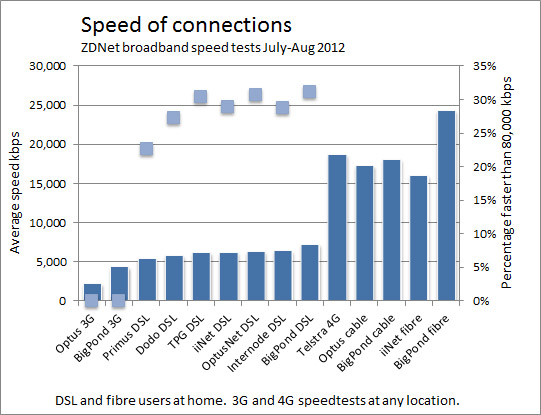Up to speed: Telstra still hard to beat

Telstra has a reputation for delivering fast wireless services through its Next G network, but they also seem to lead the way with fibre, DSL and cable.

The cautionary note is that this is based on people taking the ZDNet Speed Test — so it's a cross section of the Australian population geeky enough to run the test, and it represents just one point in time. It doesn't have the mathematical rigour of constantly tracking speeds across a representative sample of users over an extended period of time. Still, with around 20,000 test results from July and August this year, it is based on a lot of data, and does provide a worthwhile snapshot. What's more, earlier Broadband Speed Test results have shown the same thing — Telstra does seem to be faster.
Back in March, Telstra's DSL users averaged a speed of a little under 6.5 megabits per second (Mbps). Now, the speed is up around 7.2 Mbps. That makes them 14 percent above the average speed for Optus, and 17 percent faster than iiNet and TPG (both around 6.1 Mbps). It's not a huge differential, but enough to ask the question of why? Why does Telstra consistently out-rate competitors who are using similar, and often the same, infrastructure.
The question is even more pertinent when it comes to fibre, where the NBN promises a level playing field. Yet, Telstra's average speed (24 Mbps) is 50 percent faster than iiNet's (16 Mbps). It can only be that Telstra is selling a higher ratio of higher plans, keeping lower spending users on their own network. iiNet is probably keener to move customers to fibre, particularly if they're currently an off-net user, reliant on Telstra's infrastructure.
Telstra also wins when it comes to cable speeds, although the differential is less pronounced; 18 Mbps for Telstra, 17.2 Mbps for Optus. Given the song and dance made about the national roll-out of DOCSIS3.0 upgrades to their hybrid-fibre coaxial (HFC) network, promising speeds of 100 Mbps, it's surprising the differential isn't greater, and the speeds faster.
In the wireless space, Telstra's 3G does seem to have a large lead on Optus — although, it should be noted that we measured only 36 speed tests from Optus 3G users. Even with Telstra, there were only 206 3G users, with an average speed of 4.3 Mbps. The fact that there were almost as many 4G users (154 tests) shows how quickly subscribers are moving to the new network, which averaged an impressive 18.6 Mbps. Of course, the impetus for a 4G test will be more "let's see what this network is capable of," rather than "why is this network so slow?", so results will be skewed favourably.
Overall, though, it's further evidence that Telstra's network investments are reaping rewards. Or the power of incumbency provides network advantages that others cannot match. It depends on your perspective. And average speeds continue to lurch forward, putting paid to the argument that we're happy with the speeds we've got. We want more, and we want it now.
Tests measured July to August 2012: Optus 3G 36; BigPond 3G 206; Primus DSL 393; Dodo DSL 450; TPG DSL 3043; iiNet DSL 2166; OptusNet DSL 988; Internode DSL 746; BigPond DSL 4889; Telstra 4G 154; Optus cable 1646; BigPond cable 2541; iiNet fibre 93; and BigPond fibre 164.